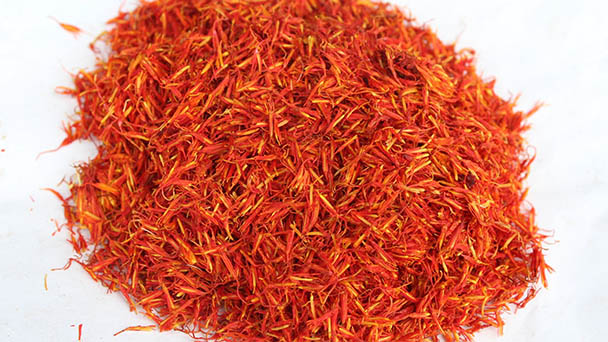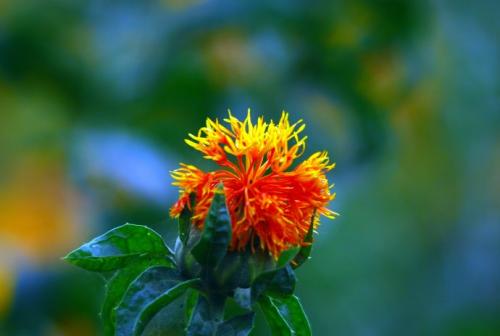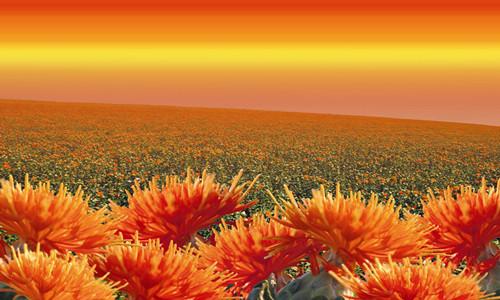Carthamus tinctorius L. profile
Written by Maggie
Nov 16 2020

Carthamus tinctorius L., is a dry tubular flower, orange-red, narrow tube, 5-lobed apex, narrow linear lobes, yellow anthers, united into tubes, higher than the lobes, with a stigma exposed in the center. It has a specific aroma and slightly bitter taste. The ones with long flower pieces, bright red color and soft quality are better.
Carthamus tinctorius L. is mainly produced in Henan, Hunan, Sichuan, Xinjiang, Tibet and other places. Promoting blood circulation, clearing blood stasis and relieving pain, it is helpful to treat amenorrhea, dysmenorrhea, lochia, chest pain, stasis, abdominal pain, chest pain, bruises, sore swelling and pain. It has the effects of promoting blood circulation and removing blood stasis, dissipating dampness and swelling. Avoid using it by pregnant women, otherwise it will cause miscarriage.
Carthamus tinctorius L. picture

Morphological characteristics of Carthamus tinctorius L.
Carthamus tinctorius L. Carthamus is an annual herb. Height is 50-100 cm.
The stem of Carthamus tinctorius L. is upright, the upper part is branched, and all stems and branches are white or pale white, smooth, and hairless. The middle and lower stems and leaves are lanceolate, lanceolate, or oblong, 7-15 cm long, 2.5-6 cm wide, with large serrations, heavy serrations, small serrations or even whole without serrations, with few feathers Shaped and deeply parted, with acupuncture on the top of the tooth.The length of the needle is 1-1.5 mm, the upward leaves are gradually smaller, lanceolate, with serrated edges, and the tooth tip is longer and 3 mm long. All leaves are hard and leathery, with no hairs on both sides, no glands, shiny, stalkless at the base, and half embracing.
Carthamus tinctorius L. has many heads, arranged in corymbs at the top of the stems and branches, surrounded by bracts, bracts elliptical or ovate-lanceolate, including the tip needles with a length of 2.5-3 cm and needles on the edge puncture, acupuncture length of 1-3 mm, or without acupuncture, the tip is gradually longer, with a grate-like acupuncture, acupuncture length is 2 mm. The involucre is ovoid, 2.5 cm in diameter. Involucral bracts 4 layers, outer harp-shaped, middle or lower part with overflow, constricted and above leaf matter, green, no needles or dentate needles at the edges, needles up to 3 mm, apex acuminate, with 1-2 mm long, yellowish-white below the overflow; middle and inner dura mater, oblanceolate elliptic to long oblanceolate, up to 2.3 cm long, with a pointed tip. All bracts are glabrous and have no glands. The florets are red, orange. The corolla is 2.8 cm long and the thin tube is 2 cm long. The corolla lobes almost reach the base of the eaves.
The achenes of Carthamus tinctorius L. are obovate, 5.5 mm long, 5 mm wide, milky white, with 4 ribs, which extend from the top of the fruit and have a side surface. Crestless. Flower and fruit period from May to August.
Growth environment of Carthamus tinctorius L.
Carthamus tinctorius L. likes a warm, dry climate, has strong cold resistance and is resistant to barrenness. It is resistant to drought and waterlogging and is suitable for planting on well-drained, moderately fertile sandy soil. Oily sandy soil and purple sandy soil are the most suitable. The seeds are easy to germinate and can germinate above 5℃. The suitable temperature for germination is 15-25℃, and the germination rate is about 80%. It is highly adaptable and has a life cycle of 120 days.
⑴Moisture: Carthamus tinctorius L. has a well-developed root system, which can absorb moisture in the deep layers of the soil. If the air humidity is too high, the soil humidity is too high, which will cause various diseases to occur. When the temperature in the seedling stage is below 15°C, short-term accumulation of water in the field will not cause dead seedlings; in the hot season, even short-term accumulation of water will cause the safflower to die. When raining occurs during the flowering period, pollen growth is stunted. During the fruit ripening stage, continuous rain and rain will cause seeds to germinate and affect the yield of seeds and oil.
Although Carthamus tinctorius L. is drought-tolerant, proper irrigation is necessary to obtain high yields in arid climates.
⑵Temperature: Carthamus tinctorius L. has a wide range of adaptation to temperature, and can germinate and grow in the range of 4~35℃. The optimum temperature for seed germination is 25~30℃, and the optimum temperature for plant growth is 20~25℃. Low temperature of about 10℃ during pregnancy bud and flowering period will cause poor development of flower organs. In severe cases, flower heads cannot open normally, and small open flowers.
⑶Light: Carthamus tinctorius L. is a long-day plant. The length of sunshine not only affects the length of the rosette period, but more importantly, it affects its flowering and fruiting. Adequate light conditions enable Carthamus tinctorius L. to develop well and have plump and plump grains.
⑷Nutrition: Carthamus tinctorius L. can grow on soils with different fertility. Reasonable fertilization is one of the measures to obtain high yield. With sufficient soil fertility and comprehensive nutrient content, the yield will be high.
⑸Soil: Although Carthamus tinctorius L. can grow on various types of soil, the fertile neutral loam with deep soil layer and good drainage is the best.
Geographical distribution of Carthamus tinctorius L.
Carthamus tinctorius L. is native to Central Asia. It is wild and cultivated in the Soviet Union, and cultivated in Japan and North Korea. It is also planted in Henan, Xinjiang, Gansu, Shandong, Zhejiang, Sichuan and Tibet. In addition to the introduction and planting of species in the above-mentioned areas in China, wild ones have also been seen in Shanxi, Gansu, and Sichuan.

Cultivation techniques of Carthamus tinctorius L.
Selective seeding
Site selection: Carthamus tinctorius L. does not have strict requirements on the soil, but to obtain high yields, you must choose medium and high-grade soils with deep soil layers, uniform soil fertility, and good drainage. The terrain is flat, with good drainage and irrigation conditions. The first crop is preferably soybeans and corn.
Seed preparation: Choose Carthamus tinctorius L. suitable for local cultivation
Fertilization: The previous crop of Carthamus tinctorius L. should be plowed, fertilized and irrigated immediately after harvest. Apply 1 to 1.5 tons of farm manure, 8 to 10 kg of urea, 8 to 10 kg of phosphate fertilizer, 1 kg of zinc fertilizer, and 3 to 5 kg of potassium fertilizer per mu for plots where available potassium is less than 350 kg/kg. Before ploughing the ground, make all the base fertilizer and spread it evenly on the ground, and then turn it deep into the soil. The quality of the arable land should be not heavy and leak-proof, the depth should be consistent, the buckle should be tight, there is no furrow plough beam, and autumn irrigation, winter turning, and spring rake can be used for soil preparation the way. The quality of soil preparation should meet the six-character standards of "equal, flat, loose, broken, clean, and moisture".
Chemical removal: Use trifluralin 80~100ɡ with 30㎏ of water for soil treatment before harrowing the ground, and spray evenly with a mechanical sprayer to prevent heavy spraying and no leakage. Use a light disc harrow and harrow immediately after spraying Mix the medicine and soil well and rub the depth 4~5cm.
sowing:
⑴Determination of the sowing date: Carthamus tinctorius L. can be sowed when the ground temperature of 5cm is stable and above 5℃. Early sowing can increase the yield. The suitable sowing date for safflower in this area is generally from late March to early April.
⑵Sowing method and sowing amount: The sowing method of Carthamus tinctorius L. uses a grain planter to sow, 45㎝ equal row spacing, 4~5㎝ depth, 50 seeds per meter, and even seeding. The broadcast line is straight and the broadcast depth is consistent. No rebroadcast or missed sowing, tight soil cover, and steady suppression, the sowing rate per mu is 2~2.5㎏.

Latest Updated
- Benefits of Bugleweed - 7 Science-backed Health Benefits
- Bugleweed Dangers & Side Effects - Is It Poisonous?
- How to Plant Evergreen Trees - What You Should Know
- When to Plant Evergreens - Grow Guide for Evergreen Trees
- 12 Wonderful Evergreen Shrubs for Your Garden
- 12 Popular Evergreen Plants with Pictures for Beginners
- When And How To Prune A Lilac Bush Like a Pro
- How to Grow & Care for Lilac Vine (Hardenbergia Violacea)
- Japanese Lilac Tree (Syringa Reticulata) Care & Propagation Guide
- Shumard Oak Pros and Cons - What to Know
Popular Articles
- Winter maintenance of Antirrhinum Majus
- How to Grow Terminalia Mantaly Tree
- How to Grow and Care for Crossostephium Chinense
- How to grow Antirrhinum Majus in spring
- Peristeria Elata (Dove Orchid) Profile: Info & Care Guide
- Underwatered Snake Plant (Sansevieria Trifasciata) - Signs And How To Fix
- How to Care for Brazilian Jasmine Plant (Mandevilla Sanderi)
- How to Grow & Care for Graptopetalum Purple Delight in Summer
- Rosa Chinensis (China Rose): Plant Growing & Care Tips
- How to Care for Baby Sun Rose (Aptenia Cordifolia)